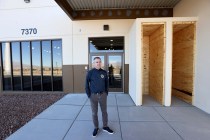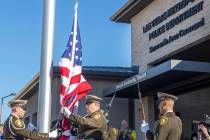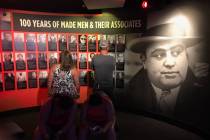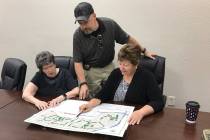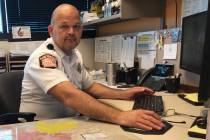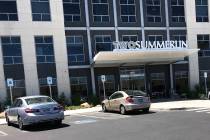Hughes originally envisioned Summerlin as site for aircraft-related industries
Could you imagine all of Summerlin being developed as an industrialized site “to test new and improved radar control and guided missile devices for the military?” Unthinkable.
What if the entire pristine desert that ultimately became known as Summerlin, sitting at the foothills of the Red Rock Canyon National Conservation Area, had been converted into a vast supersonic airport? Preposterous.
And what if the 22,500 acres of what is arguably the most exciting, extraordinary and valuable master-planned community in America were instead designed as a heavily commercialized site to serve various sectors of the aircraft industry? Absurd.
Well, it almost happened that way. Fortunately, and thanks to a mere quirk, stronger heads were able to prevail.
Instead, we now proudly witness the day-by-day shaping of Summerlin into a growing and glowing community of homes, retail shopping, entertainment, restaurants and office commerce.
We find that construction of new neighborhoods of homes — in some cases starting at prices near the $200,000 level, and in other cases at prices well in excess of $500,000 — is becoming a common sight in Summerlin. And with the economy again kicking in the right direction, folks are in a buying mood.
Then there’s the Shops at Summerlin, which soon will become the core and pride of Summerlin. We look forward to fall when the first phase of this retail shopping and commercial office bonanza is set to open. And that’s only the start. Offices, more retail shops, restaurants, town houses, entertainment facilities and pedestrian walkways in a park-like setting will follow, all within a 400-acre area that will become known as Downtown Summerlin.
But this dream-like setting would not have turned out that way. Not if Howard Hughes had his way. That’s right. The grand old eccentric who once owned every inch of what is now Summerlin — after paying less than $3 an acre for a tract that has turned out to be the national model for master planning — had to be earnestly convinced by his closest confidants to abandon those industrialized ideas.
An insightful biography of Hughes tells how close Summerlin became to being a major hub for aircraft-related industries. The well-researched book about one of the most enigmatic and legendary figures in Las Vegas’ history is called “Howard Hughes: Power, Paranoia & Palace Intrigue.”
It was authored by Geoff Schumacher, who once wrote a public affairs column for the Las Vegas Review-Journal. Schumacher also served as director of community publications for Stephens Media before moving on to Iowa to become publisher of the Ames Tribune. That newspaper and the Review-Journal are owned by Stephens Media, from which Schumacher recently resigned to become director of content development for the Mob Museum.
Historians refer to Hughes as one of the most dynamic individuals in Las Vegas’ brief history. Schumacher’s book quotes one noted executive who said, “I think Howard Hughes is the biggest thing that’s happened to Las Vegas since, I’d say, Bugsy Siegel.”
Despite his addictions, phobias, behavioral patterns and peculiar habits, Hughes had a close circle of trustees, but he maintained a strong command over all business decisions.
He called the land that we know as Summerlin “Husite.” The name is believed to be a contraction for “Hughes’ site.” According to the book, he planned to use the property to test new radar control and guided missile devices for the military, “ostensibly because a West Coast location was too vulnerable to attack.”
Hughes Aircraft was based in Culver City, Calif. “But Hughes was spending a lot of time in Las Vegas, and he got the idea to move his aircraft research facilities to the desert. He also saw tax advantages,” the book explains. That was in the early 1950s.
“But Hughes Aircraft executives put up stiff resistance to Hughes’ relocation plan, and eventually he abandoned it.”
Still, Hughes continued to visualize plans for the location that were far detached from the lush community that we now know as Summerlin.
“When he moved to Las Vegas in 1966, Hughes pondered the idea of building a supersonic airport on the Husite property, but it never materialized. Thus, Husite sat vacant for 35 years,” the book says.
That is until it was renamed Summerlin, the maiden name of Hughes’ grandmother. That occurred in 1988, a dozen years after the death of the entrepreneur.
Herb Jaffe was an op-ed columnist and investigative reporter for most of his 39 years at the Star-Ledger of Newark, N.J. His most recent novel, “Double Play,” is now available. Contact him at hjaffe@cox.net.








